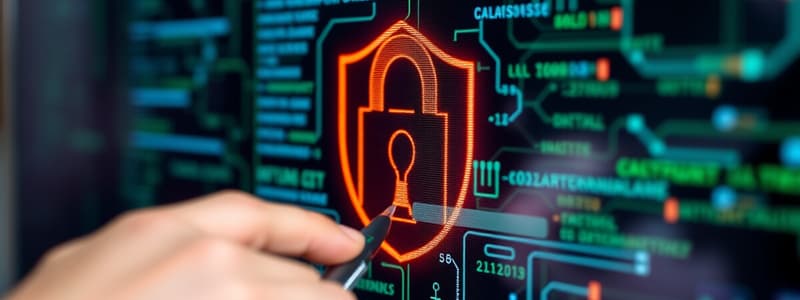Podcast
Questions and Answers
Which of the following aspects of cybersecurity ensures that information remains accurate and reliable?
Which of the following aspects of cybersecurity ensures that information remains accurate and reliable?
- Authentication
- Availability
- Integrity (correct)
- Confidentiality
What is the primary motivation behind cyberattacks that involves stealing data or money?
What is the primary motivation behind cyberattacks that involves stealing data or money?
- Disruption
- Espionage
- Vandalism
- Financial Gain (correct)
Which type of hacker is known for defending systems on behalf of organizations?
Which type of hacker is known for defending systems on behalf of organizations?
- Gray Hat Hackers
- Script Kiddies
- Black Hat Hackers
- White Hat Hackers (correct)
Which of the following is an example of a vulnerability in a system?
Which of the following is an example of a vulnerability in a system?
What kind of attack involves unauthorized access to influence or harm public infrastructure?
What kind of attack involves unauthorized access to influence or harm public infrastructure?
What do Incident Responders do in the context of cybersecurity?
What do Incident Responders do in the context of cybersecurity?
Which of the following strategies is specifically designed to detect malicious activities on a network?
Which of the following strategies is specifically designed to detect malicious activities on a network?
Which organization is known for its role in international cooperation against cybercrime?
Which organization is known for its role in international cooperation against cybercrime?
What is the primary function of SELinux?
What is the primary function of SELinux?
Which command-line tool is specifically used to configure granular ACLs in Linux?
Which command-line tool is specifically used to configure granular ACLs in Linux?
Which of the following is a common attack associated with using public Wi-Fi?
Which of the following is a common attack associated with using public Wi-Fi?
What is a recommended practice for password security?
What is a recommended practice for password security?
Which type of encryption uses the same key for both encryption and decryption?
Which type of encryption uses the same key for both encryption and decryption?
What is an effective way to mitigate risks when using public Wi-Fi?
What is an effective way to mitigate risks when using public Wi-Fi?
What should be avoided when creating strong passwords?
What should be avoided when creating strong passwords?
Which tool is used to manage IPv4 ACLs for network traffic in Linux?
Which tool is used to manage IPv4 ACLs for network traffic in Linux?
What is the primary role of national cybersecurity agencies?
What is the primary role of national cybersecurity agencies?
Which of the following is a purpose of protecting networks and data?
Which of the following is a purpose of protecting networks and data?
Discretionary ACLs (DACLs) are primarily used for what purpose?
Discretionary ACLs (DACLs) are primarily used for what purpose?
Which Windows feature provides real-time protection against malware?
Which Windows feature provides real-time protection against malware?
What type of access do System ACLs (SACLs) manage?
What type of access do System ACLs (SACLs) manage?
Which command tool can be used in Windows to set read-only access for a user?
Which command tool can be used in Windows to set read-only access for a user?
Why is international cooperation important in combating cybercrime?
Why is international cooperation important in combating cybercrime?
What is a benefit of public-private partnerships in cybersecurity?
What is a benefit of public-private partnerships in cybersecurity?
Flashcards are hidden until you start studying
Study Notes
Cybersecurity Overview
- Cybersecurity protects systems, networks, and programs from digital attacks targeting sensitive data.
- Key aspects of cybersecurity include:
- Confidentiality: Access limited to authorized users.
- Integrity: Ensuring information accuracy and reliability.
- Availability: Authorized users have consistent access to information.
- Common motivations behind cyberattacks:
- Financial Gain: Ransomware and data theft.
- Espionage: Corporate or governmental spying.
- Disruption: Hacktivism and attacks on infrastructure.
- Types of hackers include:
- White Hat: Ethical hackers helping organizations.
- Black Hat: Malicious hackers seeking personal gain.
- Script Kiddies: Inexperienced hackers using existing tools.
- High-profile cyber attacks:
- Facebook Data Leak: Personal data of over 530 million users exposed.
- Microsoft Exchange Breach (2021): Exploited vulnerabilities for malware installation.
- Twitter Bitcoin Scam (2020): High-profile account breaches.
- Impact of cyberattacks varies:
- Individuals: Identity theft, privacy invasion, financial losses.
- Organizations: Operational disruption, reputation damage, financial losses.
- Governments: National security threats and loss of public trust.
- Vulnerabilities, threats, and exploits:
- Vulnerability: Weaknesses in systems, like outdated software.
- Threat: Potential harm from exploiting vulnerabilities, such as phishing.
- Exploit: Methods that attackers use, like zero-day exploits.
- Mitigation strategies include:
- Firewalls: Control and monitor network traffic.
- Intrusion Detection Systems (IDS): Identify malicious activities.
- Patch Management: Regular system updates to close vulnerabilities.
- Cybersecurity roles include:
- Ethical Hackers: Identify system vulnerabilities.
- Security Analysts: Monitor networks and enforce security measures.
- Incident Responders: Handle and recover from attacks.
- International cybersecurity organizations comprise:
- INTERPOL Cybercrime Directorate: Coordination against cybercrime globally.
- Computer Emergency Response Teams (CERTs): National organizations managing cyber incidents.
- Government roles in combating cybercrime:
- Legislation and Regulation: Defines crimes and sets penalties.
- National Cybersecurity Agencies: Protect infrastructure and coordinate security responses.
- International Cooperation: Joint operations and information sharing between countries.
- Private sector contributions include:
- Innovation and Technology Development: Advancements in security technologies.
- Public-Private Partnerships: Collaborations for sharing threat intelligence.
- Corporate Responsibility: Ensuring customer data protection.
- Importance of network and data protection:
- Safeguard Sensitive Information: Ensures data privacy.
- Ensure Business Continuity: Maintains operational stability.
- Prevent Financial Loss: Reduces breach costs and reputational damage.
- Legal Compliance: Meets regulatory standards and prepares for audits.
- Mitigate Threats: Enhances protection against cyberattacks.
- National Security: Safeguards critical infrastructure.
- Enhance Trust: Builds customer confidence.
Access Control Lists (ACLs) Overview
- ACLs define permissions for users and systems on resource access.
- Types of ACLs:
- Discretionary ACLs (DACLs): Control user access based on permissions.
- System ACLs (SACLs): Audit access attempts and actions.
- Managing ACLs in Windows:
- Tools include icacls, Windows Explorer, and PowerShell.
- Windows security features:
- User Account Control (UAC): Limits application privileges.
- BitLocker: Encrypts drives for data protection.
- Windows Defender: Provides real-time malware protection.
- Windows Firewall: Uses ACLs for network traffic filtering.
- Linux security features:
- Distributions include Ubuntu, CentOS, and Red Hat.
- SELinux: Enforces mandatory access control policies.
- AppArmor: Confinement of applications for security.
- iptables: Configuration tool for managing network traffic.
- Managing ACLs in Linux:
- setfacl: Command-line tool for configuring granular ACLs.
- Comparing ACLs:
- Windows managed via graphical interfaces; Linux offers granular control via command line.
Cybersecurity and Protecting Your Data
- Securing Your Devices:
- Ensure firewalls are activated.
- Install and regularly update antivirus/antispyware.
- Keep operating systems and browsers updated.
- Utilize strong password protection.
- Password Security:
- Avoid reusing passwords.
- Do not store passwords in insecure places.
- Use a password manager for safe storage.
- Strong Password Guidelines:
- Avoid dictionary words and names.
- Combine over 10 characters with special symbols.
- Risks of Public Wi-Fi:
- Common attacks include Evil Twin and Man-in-the-Middle (MitM).
- Mitigation steps involve validating hotspots and using HTTPS or VPN.
- Encryption:
- Transforms readable data to scrambled form for secure access.
- Tools like Windows' Encrypting File System (EFS) utilized for encryption.
- Types of Encryption:
- Symmetric Encryption: Same key for both encryption and decryption.
- Asymmetric Encryption (Public Key): Different keys for encryption and decryption.
Studying That Suits You
Use AI to generate personalized quizzes and flashcards to suit your learning preferences.




